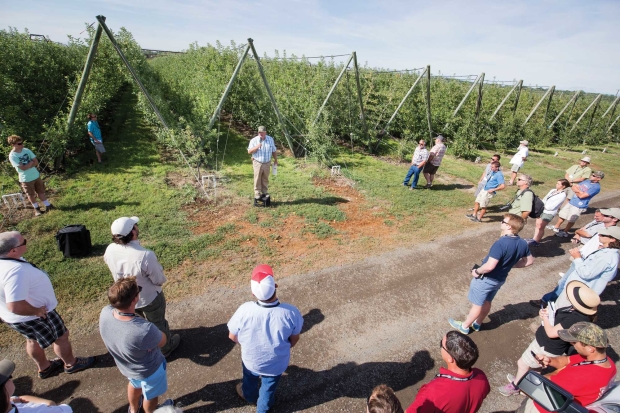
Jim Doornink explains his production strategies to IFTA tour-goers who visited his Yakima, Washington, orchard this summer. (TJ Mullinax/Good Fruit Grower)
 After a conversation three years ago about potential yields in Washington apple orchards, Yakima orchardist Jim Doornink was worried.
After a conversation three years ago about potential yields in Washington apple orchards, Yakima orchardist Jim Doornink was worried.
For many years, 35 to 50 bins per acre were considered normal yields because trees were grown on the central leader system. Now, growers were talking about yields of 90 bins per acre from high-density blocks, Doornink told members of the International Fruit Tree Association during a recent visit to his orchard.
In 2009, Doornink planted a five-acre block of Jazz, using the existing low V-trellis system to save money. The trees are 1.5 feet apart and 14 feet between rows (2,074 trees per acre), and he was concerned that the relatively wide row spacing would make it difficult to produce competitive yields.
He decided to take a more analytical approach and began thinking in terms of apples per tree. At a tree density of 2,000 per acre, one apple per tree is equal to one bin of fruit per acre. So, a yield of 70 bins per acre requires 70 apples per tree.
Last year, he counted buds in winter so that the pruning strategy could be based on the number and distribution of fruit buds on the trees and the target fruit number. Previously, the crew focused on the spatial distribution or orientation of the limbs, removing those that were growing beyond their space or too far into the middle of the row, for example.
The fruit number per tree was adjusted again during cluster thinning. Some clusters were removed and no more than one flower per cluster was retained. Next came hand fruit thinning. The result was a crop last year of more than 90 bins per acre.
Doornink said that in a Gala block that was planted at the same time and with the same system as the Jazz, the aggressive cluster thinning they did this year looked like a huge mistake at first. “It looked like we would have no crop, but when it came time to thin, we had way too many apples on here,” he said.
Doornink and his son Phil grow cherries and pears as well as apples. The Gala trees were heavily hand thinned in early summer before workers had to shift to picking cherries, but by early July it needed more heavy thinning, he said. “And I still see places where there are too many fruit,” he told the visitors.
“I’m feeling, from one year’s data, that we can do thinning at bloom time very aggressively and help our fruit size and help our workload,” he added. “We have cherry harvest that really takes us out of the orchard at a time when we need to be doing things. If we do more thinning at bloom time, it will be better.”
He expected a yield of 70 to 75 bins from the Galas this year, depending on fruit size, but thinks 80 to 90 bins are possible.
“It’s not going to happen every year,” he said. “We have to pay attention to getting things thinned earlier. The higher up the bins-per-acre curve you get, the more you have to do nothing wrong to have fruit quality be good, because you’re still constrained by the light and the rootstock.”
Multi-leader
The Doorninks’ recent plantings include Buckeye Gala on Geneva 935 and 41 rootstocks planted in 2014 on a 3-by-12-foot spacing.
The trees are trained with two leaders, making a total of 2,420 per acre, on a V-trellis that is 13 degrees from vertical. The more upright trellis is designed to maximize light distribution and also allows the tighter row spacing.
Phil said with a multi-leader system, fewer apples are needed per leader and light penetration is better. Also, less tree training is required, and pruning is simplified, which reduces the labor input.
The leaders are trained to the trellis, but the side limbs are not. Phil tries to reduce the vigor in the trees by breaking off larger lateral limbs during the summer. Limbs less than the diameter of an index finger are kept. Breaking the limbs shocks the trees, which shuts down vigor, and also improves light penetration, he said.
The goal is to produce 70 to 80 bins per acre at maturity.
Platforms
The Doorninks use platforms for picking and other orchard operations. Harvest efficiency is increased by 20 to 30 percent when workers don’t have to climb up and down ladders and walk back and forth to the bin. Another big advantage is that the workers are less physically tired at the end of the day, Jim said.
The tops of the trees are picked from the platform and the bottoms from the ground. Last year, he paid more to those who worked from the platform because no one wanted to do the platform work.
“We paid more per bin and they picked more bins per day on the platform and with the bin trailer,” he said “But we still had people who wanted to go with their wife and their ladder and go down to the other end and have their own row and pick their own bins,” Jim said. “This is a process of education. You can’t force a platform into the system. You have to convince your foreman that this is the best thing. Once he has the idea that this is going to be great, he will become adept at using it, and then, at that point, he will convince everybody else this is the greatest thing, and then the crew will go do it.”
“We bought our way into using the platform,” he added. “Now I have to get another platform.”
At harvest, he has six people on the platform, including one who drives, checks fruit quality, and does some picking.
It can accommodate eight workers for other tasks. For example, people on the front might be tying limbs to wires, while other people do suckering or thinning.
Doornink said platforms work best where people are able to move around and help each other. Otherwise, the platform can only move at the pace of the slowest person and the others have to wait. •






Leave A Comment